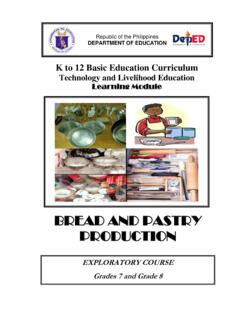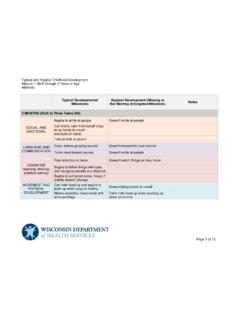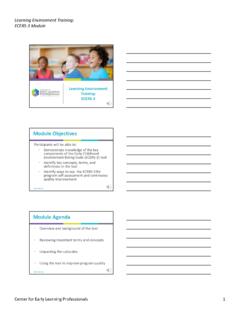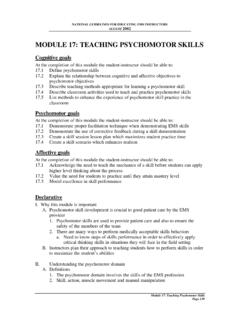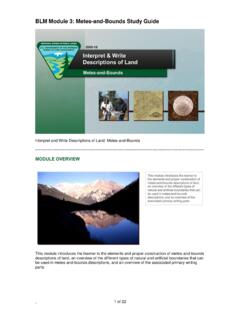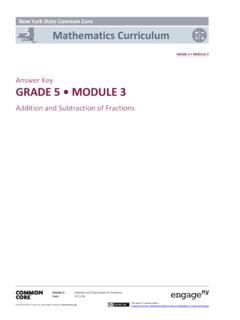Transcription of Technology and Livelihood Education Learning Module
1 Republic of the Philippines DEPARTMENT OF Education . K to 12 Basic Education Curriculum Technology and Livelihood Education Learning Module COMPUTER HARDWARE. SERVICING. EXPLORATORY COURSE. Grades 7 and Grade 8. TABLE OF CONTENTS. What Is This Module About? .. 2. How Do You Use This Module .. 3. LESSON 1 Use Hand Tools .. 4 30. LESSON 2 Perform Mensuration and Calculation .. 31 46. LESSON 3 Prepare and Interpret Technical Drawing .. 47 63. LESSON 4 Practice Occupational Safety and 64 - 103. Answer Keys .. 104 - 111. 112. COMPUTER HARDWARE SERVICING 1. K to 12 Technology and Livelihood Education What Is This Module About? Welcome to the world of Computer Hardware Servicing! This Module is an exploratory course which leads you to Computer Hardware Servicing National Certificate Level II ( NC II)1.
2 It covers 4 common competencies that a Grade 7 / Grade 8 Technology and Livelihood Education (TLE) student like you ought to possess, namely: 1) Use hand tools;. 2) Perform mensuration and calculation;. 3) Prepare and interpret technical drawing; and 4) Practice ccupational health and safety procedures. These 4 common competencies are covered separately in 4 Lessons. As shown below, each Lesson is directed to the attainment of two or more Learning outcomes: Lesson 1 Use Hand Tools Learning Outcome (LO) 1 - Prepare hand tools Learning Outcome (LO) 2- Use appropriate hand tools and test equipment Learning Outcome (LO) 3 - Maintain hand tools Lesson 2 Perform Calculation and Mensuration Learning Outcome (LO) 1 - Select components to be measured Learning Outcome (LO) 2 - Carry out measurements and calculation Lesson 3 Prepare and Interpret Technical Drawing Learning Outcome (LO) 1 - Identify different kinds of technical drawing Learning Outcome (LO) 2 - Interpret technical drawing Lesson 4 Practice Occupational Health and Safety Procedures Learning Outcome (LO) 1 - Identify hazards and risks Learning Outcome (LO) 2 - Evaluate hazards and risks Learning Outcome (LO)
3 3 - Control hazards and risks Your success in this exploratory course on Computer Hardware Servicing is shown in your ability to perform the performance standards found in each Learning outcome. 1 NATIONAL CERTIFICATE (NC) is a certification issued to individuals who achieved all the required units of competency for a national qualification as defined under the Training Regulations. NCs are aligned to specific levels within the PTQF. (TESDA Board Resolution No. 2004-13, Training Regulations Framework). NATIONAL CERTIFICATE LEVEL refers to the four (4) qualification levels defined in the Philippine TVET Qualifications Framework (PTQF) where the worker with: a. NC I performs a routine and predictable tasks; has little judgment; and, works under supervision;. b. NC II performs prescribed range of functions involving known routines and procedures; has limited choice and complexity of functions, and has little accountability.
4 COMPUTER HARDWARE SERVICING 2. K to 12 Technology and Livelihood Education How Do You Use This Module ? This Module has 4 Lessons. Each Lesson has the following parts. Learning Outcomes Performance Standards Materials/Resources Definition of Terms What Do You Already Know? What Do You Need to Know? How Much Have You Learned? How Do You Apply What You Learned? How Well Did You Perform? How Do You Extend Your Learning ? References To get the most from this Module , you need to do the following: 1. Begin by reading and understanding the Learning Outcome/s and Performance Standards. These tell you what you should know and be able to do at the end of this Module . 2. Find out what you already know by taking the Pretest then check your answer against the Answer Key. If you get 99 to 100% of the items correctly, you may proceed to the next Lesson.
5 This means that you need not go through the Lesson because you already know what it is about. If you failed to get 99 to 100% correctly, go through the Lesson again and review especially those items which you failed to get. 3. Do the required Learning Activities. They begin with one or more Information Sheets. An Information Sheet contains important notes or basic information that you need to know. After reading the Information Sheet, test yourself on how much you learned by means of the Self-check. Refer to the Answer Key for correction. Do not hesitate to go back to the Information Sheet when you do not get all test items correctly. This will ensure your mastery of basic information. 4. Demonstrate what you learned by doing what the Activity / Operation /Job Sheet directs you to do.
6 5. You must be able to apply what you have learned in another activity or in real life situation. 6. Accomplish the Scoring Rubrics for you to know how well you performed. Each Lesson also provides you with references and definition of key terms for your guide. They can be of great help. Use them fully. If you have questions, ask your teacher for assistance.. COMPUTER HARDWARE SERVICING 3. K to 12 Technology and Livelihood Education LESSON 1. Use Hand Tools Learning OUTCOMES: At the end of this Lesson, you are expected to do the following: LO 1. prepare hand tools;. LO 2. use appropriate hand tools and test equipment; and LO 3. maintain hand tools. COMPUTER HARDWARE SERVICING 4. K to 12 Technology and Livelihood Education Definition of Terms Bin - a container or enclosed space for storage.
7 Computer chassis - the enclosure that contains most of the components of a computer. Diagnostic tools - used to test the integrity of circuits and the quality of electricity in computer components and to test the functionality of computer ports. Hazards - risks; dangers. Insulation - - - - - - a material that reduces or prevents the transmission of heat or sound or electricity. Nozzle - - - - - - - - -a projecting part with an opening, as at the end of a hose, for regulating and directing a flow of fluid. Preventive - intended or used to prevent or hinder. Static electricity - an accumulation of electric charge on an insulated body. Tool - - - - - - - - - a handheld device that aids in accomplishing a task. Toolkit - - - - - - - a set of tools designed to be used together or for a particular purpose.
8 Acronyms ESD - - - - - - - - - Electrostatic discharge. USB - - - - - - - - - Universal serial bus LCD - - - - - - - - - Liquid crystal display COMPUTER HARDWARE SERVICING 5. K to 12 Technology and Livelihood Education Learning OUTCOME 1. Prepare hand tools PERFORMANCE STANDARDS. 1. Tasks to be undertaken are properly identified. 2. Appropriate hand tools are identified and selected according to the task requirements. 3. Appropriate hand tools checked for proper operation and safety 4. Unsafe or faulty tools are identified 5. Marked all tools for repair according to standard company procedures Materials 1. Workshop 2. Tables and Chairs 3. Computers 4. USB Flash Drive 5. LCD. 6. ESD Tools 7. Hand Tools 8. Cleaning Tools 9. Diagnostic Tools COMPUTER HARDWARE SERVICING 6.
9 K to 12 Technology and Livelihood Education What Do You Already Know? Let us determine how much you already know about task preparation and hand tools. Take this test. Pretest LO 1. A. Direction. Write TRUE if the statement is correct and FALSE if it is wrong. Write your answers on a separate sheet of paper. _____ 1. Selecting the best tool for each task requires training in the proper use of the tools, field experience in their safe use, and following the manufacturer's guidance and instructions for that specific tool. _____ 2. When obtaining the tool, all the associated tooling and consumable parts, as recommended by the manufacturer, must be included. _____ 3. The safe use of a tool depends on using the tool for the purpose for which it was designed and also for other purposes where it can be used as substitute where tool is not available.
10 _____ 4. All tools should be kept in good condition with regular maintenance. _____ 5. Preparing for a task includes only knowing the task to be done. _____ 6. Preparing for a task includes also the sequence of tasks to be done. B. Direction. Select the letter of the correct answer. Write your answers on a separate sheet of paper. 1. Which tool is used for hardware to stand on to prevent static electricity from building up? a. Anti-static mat c. Philips head screwdriver b. Hex driver d. Wire cutter 2. Which tool is used to loosen or tighten cross-head screws? a. Anti-static mat c. Philips head screwdriver b. Hex driver d. Wire cutter 3. Which tool is sometimes called a nut driver? It is used to tighten nuts in the same way that a screwdriver tightens screws? a.

